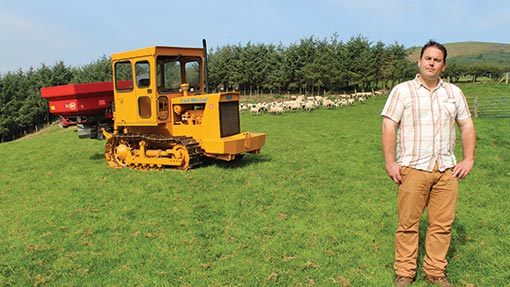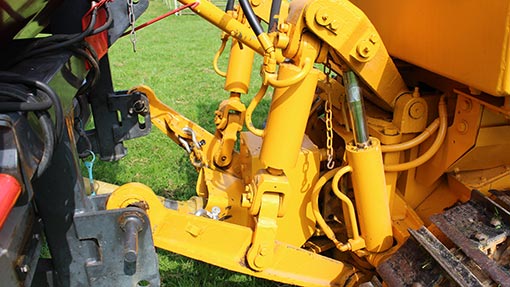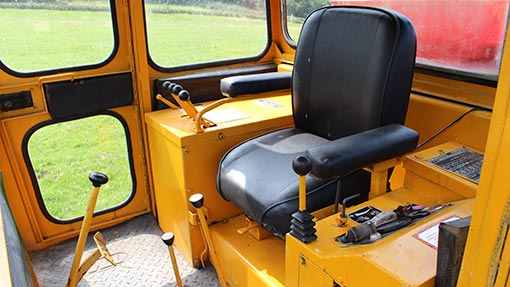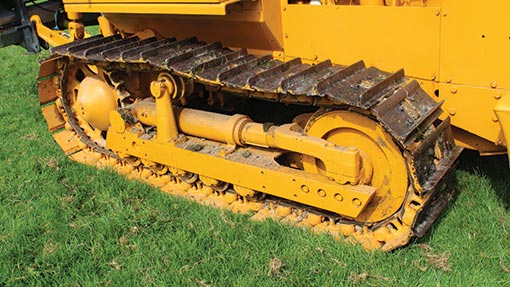Track Marshall tracked crawler attacks slippery slopes

Anyone who’s brave enough to have driven a tractor on a dewy Welsh mountainside will be familiar with the buttock-clenching moment when tyres part company with turf.
On a good day this loss of traction might cause little more than a graceful slither into a conveniently rooted conifer. But on a bad one you could end up cartwheeling into the valley bottom.
One man familiar with these perils is Powys sheep farmer Dylan Owen. He runs 850 Mule ewes on his 120ha hill farm in the village of Talerddig and has plenty of experience taking tractors where physics would rather he didn’t.
“We manage all of our grassland, however steep it is,” he says. That means venturing onto the scariest of slopes with the fertiliser spreader, topper, sprayer and chain harrows.
In a bid to find some acceptable levels of grip, he used to fit the tractor with duals and cleated wheel chains before edging down the slope in reverse. But even this setup couldn’t prevent the odd hair-raising moment.
After scouring the web for a safer alternative he settled on the idea of a Track Marshall crawler. These were built by Marshall at its Gainsborough factory and came with heavily cleated metal tracks – ideal for anchoring into turf.
Track Marshall production stopped when the Marshall business folded in the early 1990s. But thankfully, Lincolnshire dealer Robert H Crawford & Son bought all the spare parts and blueprints and it still sells refurbished models.
Mr Owen spotted a fully restored 120hp TM120 model on Crawford’s stand at the Lamma show and signed on the dotted line. The machine came in its original heavy draft spec, but Crawfords did fashion a pto transfer box to drop the speed from 1,000rpm to 540rpm. This meant Mr Owen could safely hook it to his fertiliser spreader and sprayer. The total bill came to £9,500.
When it pitched up on the farm a few months ago, the Track Marshall was put straight to work on the steep stuff.
And with thirteen metal cleats digging into the turf on each side of the machine, traction was considerably better than before, says Mr Owen. “It feels rock solid even on the steepest banks and it’ll go almost anywhere.”
The only downside of this extra grip is that it does rip the grass a bit when you put in a tight turn, he says.
So far the TM120 has spent a fair chunk of time carrying a Vicon Rotaflow fert spreader, which he still reverses up and down the banks. Grip isn’t a problem, but even with the Track Marshall’s 8t bulk and a hefty front weight, it can’t handle a full load, he says. “We can only get away with putting one bag in at a time. Any more and we’d risk losing control.”
It’s also been out with a 12m Allman sprayer on rotational thistle spraying duties as well as carrying the farm’s in-line mounted topper.
The only problem on the mowing job is that the stabiliser chains tighten when the linkage as raised and loosen when it’s lowered, he says.
“This is fine if you’re lifting a plough in and out of the ground, but when you’re topping it means the mower swings all over the place.” It should be a fairly simple workshop fix, though.
Driving it?
The TM120 comes from an altogether simpler era of tractor of tractor design.
Up front there’s a six-cylinder Ford engine rasping away and judging by the puffs of blue-grey smuts that erupt from its exhaust, it wouldn’t make many friends at an EU emissions summit.
This drives a five-speed gearbox and there’s a floor-mounted lever for shuttling between forward and reverse. Direction changes are then handled by a lever poking out of the left-hand tinwork. This operates the Track Marshall’s hydraulic tiller steering and if you push it to its extremes it applies braking bands to give a tighter turn.
On the right there’s one lever for rear lift and two others to independently adjust the link arms. There’s another lever for the single-spool valve and one to engage the pto. It’s only got a single clutch, though, so you have to stand on the foot pedal before slotting the pto into gear.
In-cab niceties go as far as a seat, rudimentary dashboard and the odd bit of padding. “It’s definitely not quiet and it’s not that comfortable either, but we bought it for safety and it scores well on that front,” says Mr Owen.
It’s hard to tell how many hours it’s notched up because it had a broken clock before it was restored. But it’s still on its original set of track pins and bushes and these are in great condition, he says.
So far the Track Marshall has been trouble-free and the only real mechanical niggle is that the brakes are a pig to adjust. The metal tracks also hammer the farm’s stone tracks, so he’s considering getting a low loader to move it around.





